How to Cite | Publication History | PlumX Article Matrix
Sergey Victorovich Vazhov
The Shukshin Altai State Academy of Education 53, Korolenko Street, Biysk, the Altai Territory, Russian Federation, 659333
ABSTRACT: The work contains materials of bird count performed on August 03-09, 2013 along the Bolshaya Rechka River within the “Bolsherechensky” state reserve. We used a standard technique of route monitoring with unlimited surveillance area. The length of the route was 59 km; the total accounting area was 17.7 km2. The total of 93 bions and 40 breeding areas of 9 species of birds have been found. Another 4 species were found in the “Bolsherechensky” state reserve and its neighborhood during fragmentary observations in 2012. The research made it possible to conclude that the surveyed area is inhabited by fairly significant populations of common honey buzzards, black kites, sparrow hawks, common buzzards, greater spotted eagles, white-tailed eagles and hobby falcons. The greatest number is observed in populations of black kites (27-28 nesting couples) and sparrow hawks (19-20 couples).
KEYWORDS: Falconiformes; Strigiformes; birds of prey; raptors; birds distribution; birds abundance; the Bolshaya Rechka River; the “Bolsherechensky” state reserve
Download this article as:| Copy the following to cite this article: Vazhov S. V. The Shukshin Altai State Academy of Education 53, Korolenko Street, Biysk, the Altai Territory, Russian Federation, 659333. Biosci Biotech Res Asia 2015;12(2) |
Introduction
The “Bolsherechensky” state integrated nature reserve of regional significance was created in 1973 for the preservation of natural complexes of the Verkhneobsky woodland, reproduction and preservation of the complex of animals in pine forests, improvement of hunting lands as the habitat of wildlife, and the protection of habitats of rare and endangered species – white-tailed eagle (Haliaeetus albicilla Linnaeus, 1758) and black stork (Ciconia nigra Linnaeus, 1758) [1].
Falconiformes and Strigiformes, constituting a distinct ecological group of avian predators are the top level of the ecological pyramid; therefore they are most vulnerable and sensitive to environment changes caused by the influence of human activity. The state of carnivorous birds’ population can serve as a criterion of well-being of certain natural areas [2].
Birds of prey play a special role in natural selection. They mainly kill sick, weak and inferior animals, and thereby prevent spreading diseases and contribute to the health of the species. Moderate “predation” often reduces density of the dominants, thus providing the possibility for less competitive species to use space and resources better [3]. The aesthetic significance of birds of prey is also undisputed, especially nowadays, when more and more people seek recreation in the nature. Birds are an essential element of foothill ecosystems and an attire of the nature of the region, giving special beauty to the natural landscapes.
The modern state of nesting groups of many species of birds of prey in the Altai Territory is of great concern. Survival of many of them is currently questioned, since many threats are caused by extremely unsustainable forest management, mining, agricultural use of the steppe areas, infrastructure of the energy complex, poaching and other human activities. This is caused by the absence of effective legal protection of avian predators in the territory of the Altai Territory and the neighboring regions of the Russian Federation [4, 5, 6]. Most Special Protected Natural Areas in the region either do not include biotopes important for birds of prey, or even formally are unable to protect these species. This raises the need for detailed studying distribution and population of falconiformes and owls, and for permanent monitoring of their still remaining nesting groups.
However, distribution and abundance of falconiformes and owls in the “Bolsherechensky” state reserve have virtually not been studies until recently. Literature [1, 7, 8] only shows references to meeting black kites (Milvus migrans Boddaert, 1783), goshawks (Accipiter gentilis Linnaeus, 1758), sparrow hawks (Accipiter nisus Linnaeus, 1758), common buzzards (Buteo buteo Linnaeus, 1758), the white-tailed eagles, the Eurasian hobby falcons (Falco subbuteo Linnaeus, 1758), the Ural owl (Strix uralensis Pallas, 1771) and the Siberian gray owl (Strix nebulosa J. R. Forster, 1772) in the reserve, without specifying locations of these meetings, the number of nesting territories or any population estimates. Therefore, in 2013 we conducted targeted surveys of birds of prey in the valley of the Bolshaya Rechka River within the limits of the reserve, the results of which was the basis of this article.
Natural Conditions in the Studied Area
The “Bolsherechensky” reserve is located almost in the center of the Eurasian continent, in the South-East of the West Siberian plain (Fig. 1) on the right bank of the Ob River, within the floodplain and upland fringes.
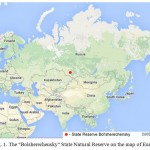 |
Figure 1: The “Bolsherechensky” State Natural Reserve on the map of Eurasia |
Administratively, it belongs to the Troitsky district of the Altai Territory of the Russian Federation; the total area of the reserve is 33.6 hectares. Terrain elevation above sea level ranges between 100 and 200 m. Average temperature in January is 17 … 18 °C, in July – +15 °C. Stable snow cover lasts for 140-150 days per year. The average amount of precipitation per year is about 500 mm [1, 9].
The hydrographic network of the nature reserve is thick; it consists of right feeders of the Ob River, floodplain lakes and swamps. The main and the largest watercourse is the Bolshaya Rechka River – the right tributary of the Ob River. It starts in the neighborhood of vil. Gornovoe in the Troitsky region of the Altai Territory. The length of the river is 258 km, its catchment area is 4,000 km2, water consumption at the distance of 122 km away from the estuary is approximately 4.5 m3/sec [10, 11]. The catchment of the Bolshaya Rechka River contains about 300 lakes with the total area of 28.9 km2 [10]. The upper and middle parts of the basin are located on ridgy Biysk-Chumysh upland with a dense network of ravines with swamped bottom. The lower part is located in the ancient valley of the Ob River featuring a ravine-ruffed relief. Before vil. Zagainovo, the valley of the Bolshaya Rechka River has the well articulated nature, and steep slopes 20-40 m high. Below, the valley is poorly articulated. The floodplain is developed almost along the whole length, but especially in the middle and lower courses. In the lower course, the floodplain is annually inundated; its width reaches 5 km. During the spring flood (in April), water level reaches 2-3 m, and during rain floods – 0.1 – 0.2 m. The river never dries off and does not freeze down to the bottom. Freezing is observed between mid-November and early April. Below vil. Zagainovo (border of the Verkhne-Ob pine wood) the Bolshaya Rechka River has been used for log driving, so the riverbed in the lower reach is littered with sunken logs [10].
The landscape of the “Bolsherechensky” reserve is in general an intrazonal forest. The type of the landscape is lowland alluvial-eolian dune-ridge and sandy [1]. It is dominated by the landscapes of sandy forests turf-and-cryptopodzol soils, complicated by impregnated wet small-leaved forests, as well as herb and moss swamps. Considerable areas are occupied by landscapes of floodplains dissected by dead lakes and canals with gramineous-mixed herbs and sedgy bushy meadows and poplar groves on alluvial meadow-and-marsh soils [9].
Vegetation of the reserve is mostly characterized by forest communities; its territory belongs to Verkhne-Ob woodland. Along high ridges and knolls there are pine forests, in degradations – birch, aspen and mixed woods, sometimes forest meadows, herbaceous and turf swamps, occasionally lakes are observed. Along the banks of the Bolshaya Rechka River there are floodplain forests that mainly consist of black poplars (Populus nigra Linnaeus, 1753) and white poplars (Populus alba Linnaeus, 1753). The main forest-forming tree is white poplar [1]. Occasionally, large specimens of Siberian larch (Larix sibirica Ledeb., 1833) are met.
Materials and Methods
The work contains materials of bird count performed on August 03 through 09, 2013 along the Bolshaya Rechka River in the framework of the “Rare Species of the Altai Reserves are in Danger!” project, supported by a grant from Global Greengrants Fund. Rafting was performed along the river from vil. Zagainovo to vil. Listvyanka; the length of the route (Fig. 2) was 59 km. Expedition group of two people traveled on two twin inflatable boats, covering 8.4 km per day on the average. Since, as a rule, the width of terrain survey during the rafting did not exceed 300 m, the overall accounted area was approximately 17.7 km2.
Fort bird count, a standard method of route monitoring with unlimited surveillance area was used [2, 12]. The birds were observed through binoculars with optical image stabilization Canon 8×25 IS. In accordance with the method, all occurring Falconiformes and Strigiformes were recorded along the route. For each bird, the distance between the observer and the bird at the first moment of detection (detection range) was determined. In order to calculate density for each specie, the average detection range was calculated by the aggregate detections. The abundance of species was estimated on the basis of their density obtained during accounting.
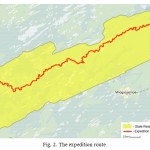 |
Figure 2: The expedition route |
Upon detection of a breeding area, its geographic coordinates were recorded using a personal satellite navigator, and entered into the electronic database of GIS program Arc View GIS 3.2 a, where spatial data were further processed. By breeding areas we mean the areas where nests or adult birds in pairs during the breeding season, unbroken aeries, courting adult males were found, or single adult birds, concerned about humans or other predators.
During the rafting, 93 bions were encountered, and 40 breeding areas of 9 bird species (8 species of falconiformes and one of owls) were found. Another specie of falconiformes and three species of owls were encountered in the “Bolsherechensky” reserve and its environs in 2012 in course of fragmentary observations within the framework of the project “Save avian predators in the Verkhne-Ob pine-wood!” supported by a grant from the Global Green grants Fund.
Main part
Pernis apivorus (Linnaeus, 1758) – ordinary honey buzzard
This specie was not detected by I. I. Chupin and V. Y. Petrov [7] in May 2004 on the route along the Bolshaya Rechka River. We met 16 of honey buzzards, 7 of which were young birds (fledglings of this year). Density was of 1.35 bions per 1 km2, or 2.71 bions per 10 km of the river valley. 5 breeding territories (Fig. 3) were found, in four of them couples of adult birds with young aeries were encountered, and in one of them – an adult bird showing worry to greater spotted eagles (Aquila clanga Pallas, 1811).
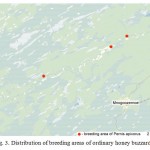 |
Figure 3: Distribution of breeding areas of ordinary honey buzzards |
Density of honey buzzards in the breeding areas was 2.8 breeding couples per 10 km2, or 0.85 couples per 10 km of the length of the river valley. The distance between neighboring breeding areas of honey buzzards ranged from 2.8 to 12.4 km, averaging 5.68 km. Basing on this data, we can assume that in the valley of the Bolshaya Rechka River, within the limits of the reserve, 10-11 nesting couples of these birds were found. However, concentration of honey buzzards’ breeding areas is noteworthy in less marshy part of the valley adjacent to the vil. Lesnoy and vil. Zagainovo (Fig. 3). The observed broods contained 1 to 2 fledglings, the average being 1.75 fledglings per brood (n=4).
Milvus Migrans (Boddaert, 1783) – Black kite
This is the most common representative of falconiformes observed by us along the route. All in all, were met 43 bions, at least 22 of them are fledglings of this year. Density was of 3.64 bions per 1 km2, or 7.29 bions per 10 km of the length of the river valley. According to I. I. Chupin and V. Y. Petrov [7], on May 4-7, 2004, abundance of black kites along the Bolshaya Rechka River was 5.4 bions per 10 km of route, which can be explained by the absence of fledglings at that moment, since in the Altai territory they start leaving nests in early July [6]. Along the route, we identified 17 breeding areas of black kites (Fig. 4), most of which had unbroken broods. A nest abandoned by fledglings was found on a larch.
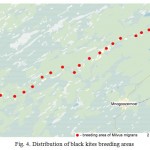 |
Figure 4: Distribution of black kites breeding areas |
The distance between neighboring breeding areas of kites ranged between 1 and 4 km, averaging 2.17 km. Based on this data, the number of kites in the valley of the Bolshaya Rechka River within the limits of the natural reserve can be estimated at about 27-28 nesting couples. Overall, distribution of breeding areas along the valley looks pretty uniform, however, slightly more dense concentration was observed in the vicinity of vil. Zagainovo (Fig. 4). The observed broods contained 1 to 3 fledglings, the average being 1.69 fledglings per brood (n=13).
Accipiter gentilis (Linnaeus, 1758) – goshawk
Along the route, we found only one adult bird of this specie (Fig. 5), which does not make it possible to make any assessment of its population size.
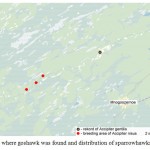 |
Figure 5: Location where goshawk was found and distribution of sparrowhawks breeding areas |
Accipiter Nisus (Linnaeus, 1758) – sparrowhawk
All in all, were met 4 sparrowhawks, 2 of them were fledglings of this year. Two times we observed unsuccessful hunt these hawks for common sandpipers (Actitis hypoleucos Linnaeus, 1758), in both cases, the predators were trying to catch prey in the air above the water surface. Density of sparrowhawks was 1.36 bions per 1 km2, or 0.68 bions per 10 km of the length of the river valley. I. I. Chupin and V. Y. Petrov [7] provide similar data (0.8 bions per 10 km of the route). Along the route, we found 5 breeding areas of sparrowhawks (Fig. 5); in one of them a nest in an aspen was found, abandoned by fledglings. All breeding areas were found in the marshiest part of the valley that is adjacent to vil. Listvyanka (Fig. 5). The distance between neighboring breeding areas of sparrowhawks ranged between 1.6 and 5.5 km, averaging 3.08 km. Basing on this data, we can assume that in the valley of the Bolshaya Rechka River, within the limits of the reserve, 19-20 nesting couples of these birds were found.
Buteo buteo (Linnaeus, 1758) – Common Buzzard
All in all, 4 birds of this specie were found; their density was 0.34 bions per 1 km2, or 0.68 bions per 10 km of the length of the river valley. Similar data (0.7 bions per 10 km of route) were provided by I. I. Chupin and V. Y. Petrov [7]. Within the limits of the route, we found 4 buzzard breeding areas (Fig. 6), all of them were found by meeting anxious adult birds. The distance between neighboring areas ranged between 3.3 and 7.0 km, averaging 4.6 km. Based on this data, the number of buzzards in the valley of the Bolshaya Rechka River within the limits of the reserve can be estimated at about 12-13 nesting couples.
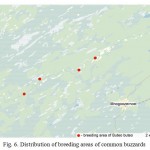 |
Figure 6: Distribution of breeding areas of common buzzards |
Aquila clanga Pallas, 1811 – Greater Spotted Eagle
Along the route, 3 birds of this specie were found; their density was 0.17 bions per 1 km2, or 0.51 bions per 10 km of the length of the river valley. In the same route in May 2004, I. I. Chupin and V. Y. Petrov [7] had never detected greater spotted eagle at all, which had been probably due to low visibility of this predator during the brooding period. Within the limits of the route we found 2 breeding areas of greater spotted eagles (both detected by presence of anxious adult birds), another breeding area was detected in 2012 in the vicinity of the Varlamenskoye Marsh Lake at the southern border of the “Bolsherechensky” reserve (Fig. 7). The distance between neighboring areas was 4.1 and 5.9 km. Based on this data, the number of greater spotted eagles in the valley of the Bolshaya Rechka River within the limits of the reserve can be estimated at about 10-14 nesting couples.
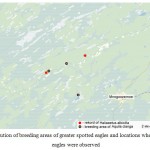 |
Figure 7: Distribution of breeding areas of greater spotted eagles and locations where white-tailed eagles were observed |
Haliaeetus albicilla (Linnaeus, 1758) – white-tailed eagle
Along the route, 2 adult white-tailed eagles were found (Fig.7); their density was 0.11 bions per 1 km2, or 0.34 bions per 10 km of the length of the river valley. Similar data (0.3 bions per 10 km of route) were provided by I. I. Chupin and V. Y. Petrov [7]. Along the route, no breeding areas of white-tailed eagle were identified, but since the adult bions that we met were probably nesting, the distance between the neighboring areas is approximately 7.7 km. Basing on this data, we can assume that in the valley of the Bolshaya Rechka River, within the limits of the reserve, about 7-8 nesting couples of these birds were found.
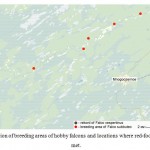 |
Figure 8: Distribution of breeding areas of hobby falcons and locations where red-footed falcons were met. |
Falco subbuteo Linnaeus, 1758 – hobby falcon
All in all, along the route we met 18 hobby falcons, 12 of which were fledglings of this year. Density was of 2.03 bions per 1 km2, or 3.05 bions per 10 km of the length of the river valley. According to I. I. Chupin and V. Y. Petrov [7], abundance of hobby falcons on May 4-7, 2004, in a similar route, was only 0.3 bions per 10 km, which is probably due to the absence of fledglings at that moment, and poorer visibility of adult birds, which only start laying eggs at the beginning May. Along the route, we found 6 breeding areas of hobby falcons (Fig. 8); in one of them a nest was found in an old nest of accipitrides (probably, black kites) in white poplar abandoned by fledglings. In other areas, unbroken broods and (or) adult birds were observed, attacking black kites and white-tailed eagles.
Distribution of breeding areas of hobby falcons along the valley looks quite uniform (Fig. 8). The distance between adjacent areas ranged between 2.0 and 9.7 km, averaging 6.0 km. Based on this data, the number of hobby falcons in the valley of the Bolshaya Rechka River within the limits of the reserve can be estimated at about 9–10 nesting couples. Observed broods had 1-3 fledglings, averaging 2.40 fledglings per brood (n=5).
Falco vespertinus Linnaeus, 1766 – red-footed falcon
In the route, red-footed falcon was not found, but an adult male of this specie was detected on July 16, 2012 on the Teleutskoye Lake, 2 km from the South-Western boundary of the “Bolsherechensky” reserve (Fig. 8). This makes it possible to suspect the presence of red-footed falcons in the reserve, including the valley of the Bolshaya Rechka River.
Bubo bubo (Linnaeus, 1758) – Eagle owl
In the route, eagle owl was not found either, but its breeding area was found on the banks of the swamped Sredneabrashkino Lake just 0.5 km to the North from the Bolsherechensky reserve (Fig. 9), where on April 25, 2012 his mating call was heard [13]. On the same day, a feather of eagle owl was found on the swamped Varlamenskoye Lake on the southern border of the reserve. Therefore, nesting of this owl in the territory of the reserve including the valley of the Bolshaya Rechka River is likely.
Asio otus (Linnaeus, 1758) – long-eared owl
Along the route, we found one breeding area of long-eared owl (Fig. 9), which does not make it possible to make any assessment of the population of this specie. Obviously, within the valley of the Bolshaya Rechka River, more than one couple of long-eared owls are breeding, however, we failed to find most of them because of the features of the birds count method used, which is not optimal for detecting owls, since it is mainly focused on falconiformes.
Strix uralensis Pallas, 1771 – Ural owl
Along the route, Ural owl was not detected, although the Red Book of the Altai Territory [1] indicates the presence of this specie in Bolsherechensky reserve. A breeding area of Ural owls was found on July 23, 2012 (a couple of birds was met) in the vicinity of vil. Chausovo, 14 km to the West of the reserve (Fig. 10), therefore its nesting in the reserve, including the valley of the Bolshaya Rechka River is very likely.
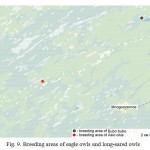 |
Figure 9: Breeding areas of eagle owls and long-eared owls |
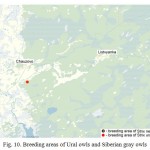 |
Figure 10: Breeding areas of Ural owls and Siberian gray owls |
Strix nebulosa J.R. Forster, 1772 – Siberian gray owl
We met an adult bird of this specie (a possible breeding area) on July 16, 2012 in a humid pine-and-aspen forest on the South-Western border of the Bolsherechensky reserve [8] (Fig. 10). An inhabited nest in an old nest of accipitrides was found on April 24, 2012 in the neighborhood of vil. Tyumen, 8 km to the North-East from the reserve [8]. We failed to find Siberian gray owls along the route, however, the data presented makes it possible to suspect them breeding in the valley of the Bolshaya Rechka River within the reserve.
Conclusions
The research made it possible to conclude that the valley of the Bolshaya Rechka River within the limits of the Bolsherechensky reserve is inhabited by a fairly significant populations of common honey buzzards, black kites, sparrow hawks, common buzzards, greater spotted eagles, white-tailed eagles and hobby falcons, which are typical raptors for the landscapes of the Verkhne-Ob forest massif. The greatest number (of the species whose abundance we managed to assess) was observed in the valley of the Bolshaya Rechka River in the population of black kites (27-28 nesting couples) and sparrow hawks (19-20 couples).
In the studied area, 10 to 14 couples of greater spotted eagles are nesting, which are listed in the Regional Red Book [14], as well as about 7-8 pairs of white-tailed eagle, which is also listed in the Red Book of Russia [15]. The probability of nesting in the reserve is also high for such rare birds as eagle owls and Siberian gray owls, also listed in the Red Book [14, 15]. We failed to find breeding areas of the latter two species, and to assess their abundance, due to the characteristics of the used methods of bird count, which is mainly focused on falconiformes. Thus, the study confirms the high value of the “Bolsherechensky” reserve as the habitat of wildlife for protecting rare and endangered species of birds, as well as for reproduction and conservation of the complex of raptors that are typical for the Verkhne-Ob forest massif.
Acknowledgments
The author is grateful to Alexei Valerievich Odintsev for his help in bird count, Victor Markovich Vazhov and Roman Bachtin for the transportation of the expedition, and Global Greengrants Fund for financial support for the research.
References
- The Red Book of the Altai territory. Specially protected natural areas, 2009. Barnaul, pp: 284.
- Karyakin, I.V., 2004. Avian predators (methodical recommendations for studying falconiformes and owls). Nizhny Novgorod, pp: 351.
- Odum, E.P., 1971. Fundamentals of Ecology. 3rd ed. Philadelphia-London-Toronto: W.B. Saunders Company., pp: 574.
- Smelansky, I.E., 2005. Altai Kray: the future of the largest raptorial diversity hotspots depends on urgent conservation measures. Raptors Conservation, 3: 18–27.
- Vazhov, S.V., 2012. Ecology and distribution of falconiformes and owls in the foothills of the Altai mountains, abstract from thesis of Candidate of Biological Sciences, 03.02.08, Barnaul, pp: 22.
- Vazhov, S.V., 2012. Falconiformes and owls of the Russian part of the Altai foothills: ecology and distribution. Saarbrücken, Germany: LAP LAMBERT Academic Publishing Gmbh& Co. KG, pp: 196.
- Chupin, I.I. and V.Y. Petrov,2005. Quantitative characteristic of birds along the Bolshaya Rechka River (the Middle-Ob pinewood). Actual Problems of Studying Birds of Siberia: In the Proceedings of the Siberian Ornithological Conference dedicated to the memory and the 70-th anniversary of E.A. Irisov, Barnaul, pp: 228–229.
- Bachtin, R.F., S.V. Vazhov and D.V. Rybalchenko, 2012. New Data on the Great Grey Owl Breeding in the Altai Kray, Russia. Raptors Conservation, 25: 138–142.
- The Altai Territory. Atlas, Vol. 1, 1978. Moscow–Barnaul, pp: 222.
- Bolshaya Rechka, Materials of the information portal of the Altai. – 2015 Date Views: 05.12.2015 http://www.altai.tv/geo-id-142.html.
- Bol’shaya Rechka At Troitskoye Ob. Materials of the R-Arctic NET website. – 2015 Date Views: 05.17.2015 http://www.r-arcticnet.sr.unh.edu/v4.0/ViewPoint.pl?Point=6719.
- Bibby, C.J., M. Jones and S. Marsden, 1998. Expedition Field Techniques. Bird Surveys. London: Royal Geographical Society, pp: 143.
- Vazhov, S.V. and D.V. Rybalchenko, 2013. Monitoring Results for Some Breeding Territories of the Eagle Owl in the Altai Kray in 2012, Russia. Raptors Conservation, 26: 109-115.
- The Red Book of the Altai territory. Rare and endangered animal species, 2006. Barnaul, pp: 211.
- The Red Book of the Russian Federation (animals), 2001. Moscow, pp: 863.

This work is licensed under a Creative Commons Attribution 4.0 International License.





